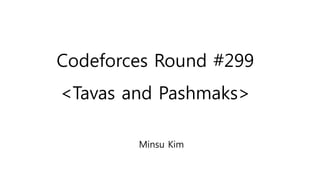Tavas and pashmaks
- 1. Codeforces Round #299 <Tavas and Pashmaks> Minsu Kim
- 2. Description ? Given a set of competitors which have ?? and ?? as its value, find the largest subset of possible winners W ? a competitor can be a winner if there exists ?, ? ° ?+ 2 where ? = ? ? ? + ? ? ? has the minimum value in the set. ? Constraints : 1 °‹ ? °‹ 2 °¡ 105, 1 °‹ ??, ?? °‹ 104
- 3. Obvious Facts ? A competitor ? cannot be a winner if another competitor ? such that ?? < ?? ??? ?? < ?? exists. ? ? (??, ??) (??, ??)
- 4. Geometric Analysis ? ? should be the minimum for ? to be a winner ? min ? = ? ? ? + ? ? ? = R, S ? 1 ? ? , 1 ? ? = R, S °¡ | 1 ? ? , 1 ? ? | °¡ cos ? ? Boxed one is the component of ? ? ? , ? ? ? in dir. of ?, ? ? Therefore, suppose R, S is any unit vector in the first quadrant and find the possible winners!
- 8. Insight ? Winners turned out to be.. the subset of Convex Hull for the points 1 ? ? , 1 ? ? ! ? Exactly, the lower-left part of the Convex Hull.
- 9. Implementation ? There are some pesky things in implementation.. 1. Precision Problem : repeated cross production of fractions ? Use integers. ? ??? ? 1 ? ? , 1 ? ? , ? 1 ? ? , 1 ? ? , ? 1 ? ? , 1 ? ? , ???????? ??????? ? ????????? ???? ?? ? ? ? ? °¡ ? ? ? = (? ??? ?)(? ??? ?) ? ? ? ? ? ? ? ? ? ? ??? ? ? ??? ? ? ? ? ? ? ? ? ? > 0 ? ? ? ? ? ? ? ? ? ? ? ? ? ? ? ? ? ? ? ? ? ? ? ? ? ? ? ? ? ? > 0 2. Duplicated Competitors : vary for the Convex Hull algorithm ? Regard as one and check it later








